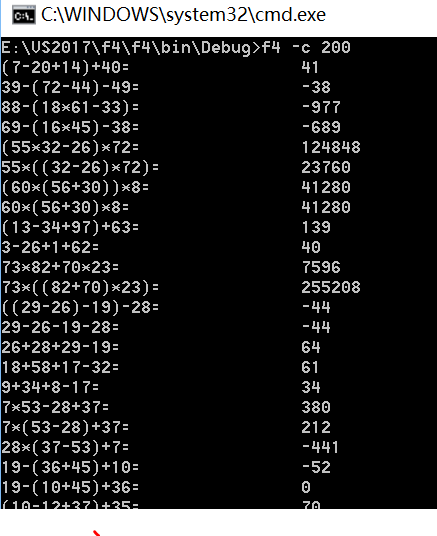对后缀表达式求值比直接对中缀表达式求值简单。在后缀表达式中,不需要括号,而且操作符的优先级也不再起作用了。可以用如下算法对后缀表达式求值:
- 初始化一个空堆栈
- 从左到右读入后缀表达式
- 如果字符是一个操作数,把它压入堆栈。
- 如果字符是个操作符,弹出两个操作数,执行恰当操作,然后把结果压入堆栈。如果您不能够弹出两个操作数,后缀表达式的语法就不正确。
- 到后缀表达式末尾,从堆栈中弹出结果。若后缀表达式格式正确,那么堆栈应该为空。
功能一的实现:
效果图如下:




参考了一个博客:计划写出3个主函数来实现这个功能,今天先写了一些其余的小函数:
using System;
using System.Collections;
using System.Collections.Generic;
using System.Linq;
using System.Text;
using System.Threading.Tasks;
//author: yy
//time:17/10/05
namespace f4
{
class arithMetic
{
static void Main(string[] args)
{
//主函数
}
class work
{
int[] numbers;
string[] optionsArray = new string[] { "+", "-", "*", "/", "(", ")" };//运算符号和括号
string[] fourOptions = new string[] { "+", "-", "*", "/" };//四则运算符
}
//运算符优先级
static int privority(string str)
{
int pri = 0;
switch (str)
{
case "+": pri = 0; break;
case "-": pri = 0; break;
case "*": pri = 1; break;
case "/": pri = 1; break;
case "(": pri = 2; break;
case ")": pri = 2; break;
}
return pri;
}
//四则运算
static int[] OptionsArithMetic(string firOps, string secOps, string ops)
{
int first= int.Parse(firOps);
int second = int.Parse(secOps);
int res = 0;
switch (ops)
{
case "+": res = first + second; break;
case "-": res = first - second; break;
case "*": res = first * second; break;
case "/": res = first / second; break;
}
return res;
}
//分割表达式,并入队列
public Queue<string> SplitExpress(string express)
{
}
//中序表达式转换为后序表达式
public List<string> InorderToPostorder(Queue<string> q)
{
}
//计算后序表达式
public bool IsResult(List<string> PostorderExpress, out decimal result)
{
}
先写个博客证明一下自己的工作,逃:)
enmmmmmm,写了函数随机生成20道四则运算题目:
//随机生成20道运算题
static void RandOut()
{
Random rd = new Random();
int num1, num2, num3, num4;
char[] fourOptions = new char[] { '+', '-', '*', '/' };//四则运算符
int i, j, charnum;
for (i = 0; i < 20; i++)
{
num1 = rd.Next();
num2 = rd.Next();
num3 = rd.Next();
num4 = rd.Next();
charnum = rd.Next() % 4;
for (j = 0; j < 3; j++)
{
if (charnum == 0)
{
fourOptions[j] = '+';
}
if (charnum == 1)
{
fourOptions[j] = '-';
}
if (charnum == 2)
{
fourOptions[j] = '*';
}
if (charnum == 3)
{
fourOptions[j] = '/';
}
Console.WriteLine(num1 + fourOptions[j] + num2 + fourOptions[j] + num3 + fourOptions[j] + num4);
}
}
}
下面是实现将遍历中序表达式转化为后序表达式:
//是否为数字,判断是否为整数字符串
static bool isNumber(string message)
{
//判断是否为整数字符串
//是的话则将其转换为数字并将其设为out类型的输出值、返回true, 否则为false
int result = -1; //result 定义为out 用来输出值
try
{
result = Convert.ToInt32(message);
return true;
}
catch
{
return false;
}
}
//判断操作符优先级大小
static bool comparePriority(string op1, string op2)
{
return getPriorityValue(op1) > getPriorityValue(op2);
}
private static int getPriorityValue(string op1)
{
throw new NotImplementedException();
}
static Stack<string> changeExpression(List<string> beforeExps)
{
Stack<string> operand = new Stack<string>();//操作数
Stack<string> opertor = new Stack<string>();//操作符
//遍历中序表示
int length = beforeExps.Count;
int len = opertor.Count;
//判断是否为操作数
for (int i = 0; i < length; i++)
{
string c = beforeExps[i];
if (isNumber(c))
{
//操作数 存在操作数栈
operand.Push(c);
}
else
{
//为运算符
//若运算符为"("直接存入到运算符栈中
if (c == "(")
{
opertor.Push(c);
}
else if (c == ")")
{
//该运算符为右括号")",则输出运算符堆栈中的运算符到操作数堆栈,直到遇到左括号为止。 将"("出栈
while (opertor.Peek() != "(")
{
string stringvalue = opertor.Pop();
operand.Push(stringvalue);
}
opertor.Pop();
}
else
{
// 该运算符为非括号运算符:
//考虑栈顶为空的情况
if (len <= 0)
{
opertor.Push(c);
continue;
}
// (a) 若运算符堆栈栈顶的运算符为括号,则直接存入运算符堆栈。
////符合为左括号 直接存入运算符
if (opertor.Peek() == "(")
{
opertor.Push(c);
}
else
{
//(b) 若比运算符堆栈栈顶的运算符优先级高或相等,则直接存入运算符堆栈。
if (comparePriority(c, opertor.Peek()))
{
opertor.Push(c);
}
else
{
// (c) 若比运算符堆栈栈顶的运算符优先级低,则输出栈顶运算符到操作数堆栈,并将当前运算符压入运算符堆栈。
string stringvalue = opertor.Pop();
operand.Push(stringvalue);
opertor.Push(c);
}
}
}
}
}
//4、当表达式读取完成后运算符堆栈中尚有运算符时,则依序取出运算符到操作数堆栈,直到运算符堆栈为空。
while (len > 0)
{
string stringvalue = opertor.Pop();
operand.Push(stringvalue);
}
//反转operand 获取正常的后缀表达式
Stack<string> resultSt = new Stack<string>();
while (len > 0)
{
string stringvalue = operand.Pop();
resultSt.Push(stringvalue);
}
return resultSt;
}
要求1 参考《构建之法》第4章两人合作,结对编程上述功能,要求每人发布随笔1篇 (代码是共同完成的,博客是分别完成的)。 (1) 给出每个功能的重点、难点、编程收获。(2)给出结对编程的体会,以及 (3) 至少5项在编码、争论、复审等活动中花费时间较长,给你较大收获的事件。 (10分)
(1)重点难点以文档形式在coding.net上,链接为:https://coding.net/u/Dawnfox/p/f4/git/blob/master/doc/%E5%9B%9B%E5%88%99%E9%9C%80%E8%A6%81%E6%B3%A8%E6%84%8F%E7%9A%84%E5%9C%B0%E6%96%B9V1.1.docx
(2)本次结对编程我的搭档是冉华同学,在这次结对编程的过程中我收获良多,之前我拿到题目后非常焦急,因为发现功能一就需要用到逆波兰表达式,但是之前编译原理学习的相关知识已经忘了,而且接触c#的时间也不过3个星期,感到一头雾水无从下手。然而冉华告诉我,拿到题目之后最好不要直接就开始写,因为心里没有一个完成计划与标准,在写作业的过程中容易顾此失彼,这样做收获很有限。听从了冉华同学的建议,我们在开始写作业之前做了时间较长的前期准备,比如:挖掘题目的隐含信息、讨论算法思想与代码编写顺序等,因为前3周的作业我都是在实验室的机器上完成的,这个国庆假期前几天实验室没有开门,所以在我自己的电脑上安装环境也花费了一定的时间。在前几天,主要通过阅读博客和问同学知道了如何在vs2017环境下进行单元测试,后来在编写程序之前我阅读了大量的博客,了解了四则运算实现的算法过程,尝试了编写功能一其中的几个函数,并且通过看冉华同学编写代码了解了有经验的同学是如何写程序的,收获了很多。我感受到基础的重要性,在编写程序的过程中会引用到常用的库函数与方法,虽然不可能完全记得这些但是最好有个印象,常用的方法一定要了解最好能够熟练使用,当然这需要大量的练习来不断地巩固,在完成一个个小任务后可以收获满足感,这样就有动力继续进行更多的编程练习。 最后,感谢冉华同学在本次作业的完成中给我的指导与帮助。

